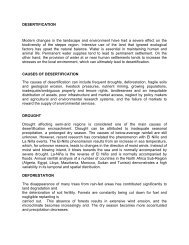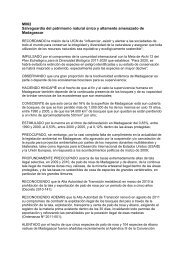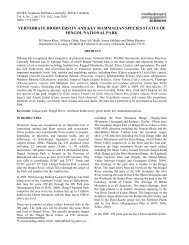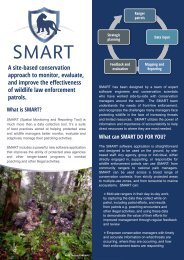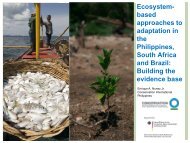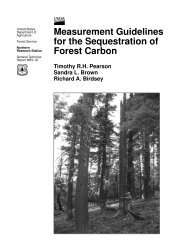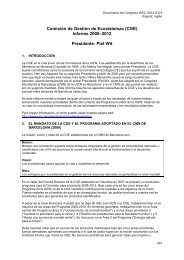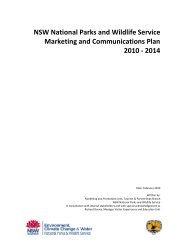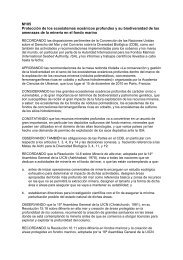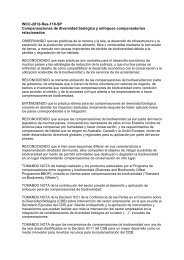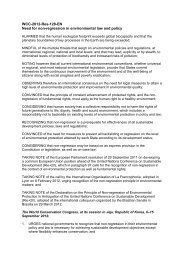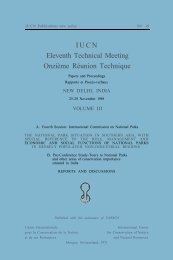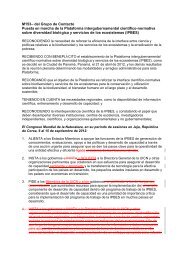You also want an ePaper? Increase the reach of your titles
YUMPU automatically turns print PDFs into web optimized ePapers that Google loves.
Annex: Case StudiesThis document presents the results of implementation of the <strong>IUCN</strong> Programme 2009–12 and isinten<strong>de</strong>d to provi<strong>de</strong> a representation of <strong>IUCN</strong>’s work over the four-year period. As this small selectionof case studies <strong>de</strong>monstrates, the work of <strong>IUCN</strong> always begins on the ground, in close cooperationwith the distributed Secretariat, Members and Commissions. It is based on these concrete examplesthat <strong>IUCN</strong> is able to carry out its mission of ‘influencing, encouraging and assisting societiesthroughout the world to conserve the integrity and diversity of nature and to ensure that any use ofnatural resources is equitable and ecologically sustainable.’Case Studies: Conserving BiodiversityThe Strategic P<strong>la</strong>n for Biodiversity 2011–2020 and the Aichi TargetsAgainst the background of the world’s failure to achieve by 2010 a significant reduction of the currentrate of biodiversity loss at the global, regional and national level as a contribution to poverty alleviationand to the benefit of all life on Earth (the so called 2010 Biodiversity Target) and the documentedcontinuous and increasing <strong>de</strong>terioration and <strong>de</strong>cline of biodiversity in all its components worldwi<strong>de</strong>,expectations were high regarding the negotiation and adoption of a new global framework to haltbiodiversity loss across all levels and sectors and urgent action was nee<strong>de</strong>d.<strong>IUCN</strong> articu<strong>la</strong>ted a clear objective for its policy work: through the preparations for the CBD TenthConference of the Parties (COP10) and for the meeting itself, the <strong>de</strong>velopment and adoption of astrong, science-based, sca<strong>la</strong>ble, achievable yet ambitious Strategic P<strong>la</strong>n for the CBD for the next<strong>de</strong>ca<strong>de</strong>. It was our aim to influence the Parties to the CBD to commit to this strong yet re<strong>la</strong>tively simpleframework at the global level. Immediately following adoption, <strong>IUCN</strong> offered its support to help“trans<strong>la</strong>te” the global targets into national level targets based on national needs assessments.<strong>IUCN</strong> prepared eight position papers which contained <strong>IUCN</strong>’s policy recommendations for COP10 onrelevant agenda items. <strong>IUCN</strong>’s position papers were well received, used as a basis for policy<strong>de</strong>velopment and were clearly appreciated by Parties. These documents were the result of a <strong>la</strong>rgeconsultation process within the Secretariat, involving <strong>IUCN</strong>’s Commissions, Council and Members.Media, including the BBC World Service to name one, saw <strong>IUCN</strong> as a source for unbiased andcontinuous information from a range of target media. As an outcome of this process <strong>IUCN</strong> had directinfluence in shaping Target 2, 5, 11, 12, and 20 and some influence on all of the other targets, byworking behind the scenes with our Members and through interventions ma<strong>de</strong> in plenary and contactgroup sessions.<strong>IUCN</strong> Assists the Birth of IPBESBecause <strong>de</strong>livering knowledge to inform conservation policies is central in its mandate, <strong>IUCN</strong> activelyparticipated in the discussions on an Intergovernmental Science-Policy P<strong>la</strong>tform on Biodiversity andEcosystem services (IPBES) since 2005, culminating in the formal establishment of IPBES as anin<strong>de</strong>pen<strong>de</strong>nt intergovernmental organization in April 2012.Rooted in the collective recognition that knowledge on biodiversity and ecosystem services is sparselydistributed and is not yet properly utilized in <strong>de</strong>cision making, IPBES has been conceived after acareful and thorough benchmarking of previous global or regional experiences to <strong>de</strong>liver assessmentsof knowledge, such as the Millennium Ecosystem Assessment, the Global Biodiversity Outlooks or,in<strong>de</strong>ed, the <strong>IUCN</strong> Red List of Threatened Species.During the negotiations, <strong>IUCN</strong> contributed substantively by collecting and sharing the lessons learnedfrom <strong>de</strong>ca<strong>de</strong>s of <strong>de</strong>livering knowledge to inform conservation policies, and providing a nongovernmentalperspective in the discussions. In particu<strong>la</strong>r, <strong>IUCN</strong> contributed to the gap analysis whichshowed the need for a mechanism such as IPBES to bridge the science and policy worlds regardingbiodiversity and ecosystem services. <strong>IUCN</strong> further advocated for the need to col<strong>la</strong>borate with existingrelevant initiatives and to involve civil society—both consi<strong>de</strong>red critically important features for thecredibility and legitimacy of IPBES.<strong>IUCN</strong> stands ready to cooperate with IPBES and has offered options for administrative and technicalsupport. <strong>IUCN</strong> also presented its f<strong>la</strong>gship knowledge products and showed how they could serve344



